Managing Human Resources: Best Practice vs Best Fit Approaches
VerifiedAdded on 2021/02/19
|11
|2711
|239
Report
AI Summary
This report provides a comprehensive overview of human resource management (HRM) approaches, specifically focusing on the 'best practice' and 'best fit' models. It delves into the advantages and disadvantages of each approach, highlighting how they influence organizational performance and employee motivation. The best practice approach emphasizes universal HR activities, while the best-fit model stresses alignment with business strategy and the external environment. The report also examines the HRM lifecycle, including recruitment, education, motivation, evaluation, and celebration, and discusses the key challenges associated with each stage. It emphasizes the importance of strategic staffing, training, and employee development for organizational success and the role of effective HR practices in providing employee security and increasing productivity. The document emphasizes the importance of both approaches in supporting organizational strategy and objectives.
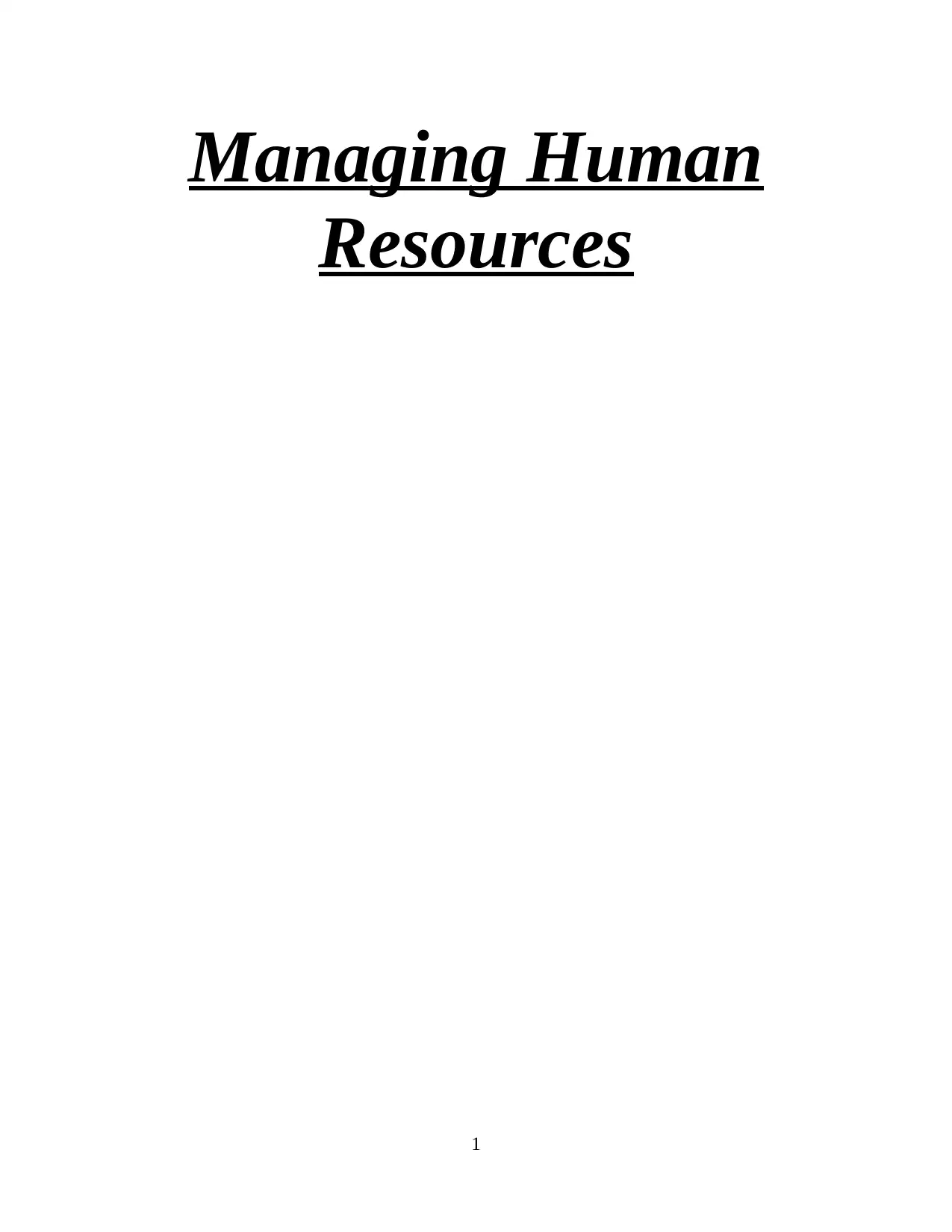
Managing Human
Resources
1
Resources
1
Paraphrase This Document
Need a fresh take? Get an instant paraphrase of this document with our AI Paraphraser
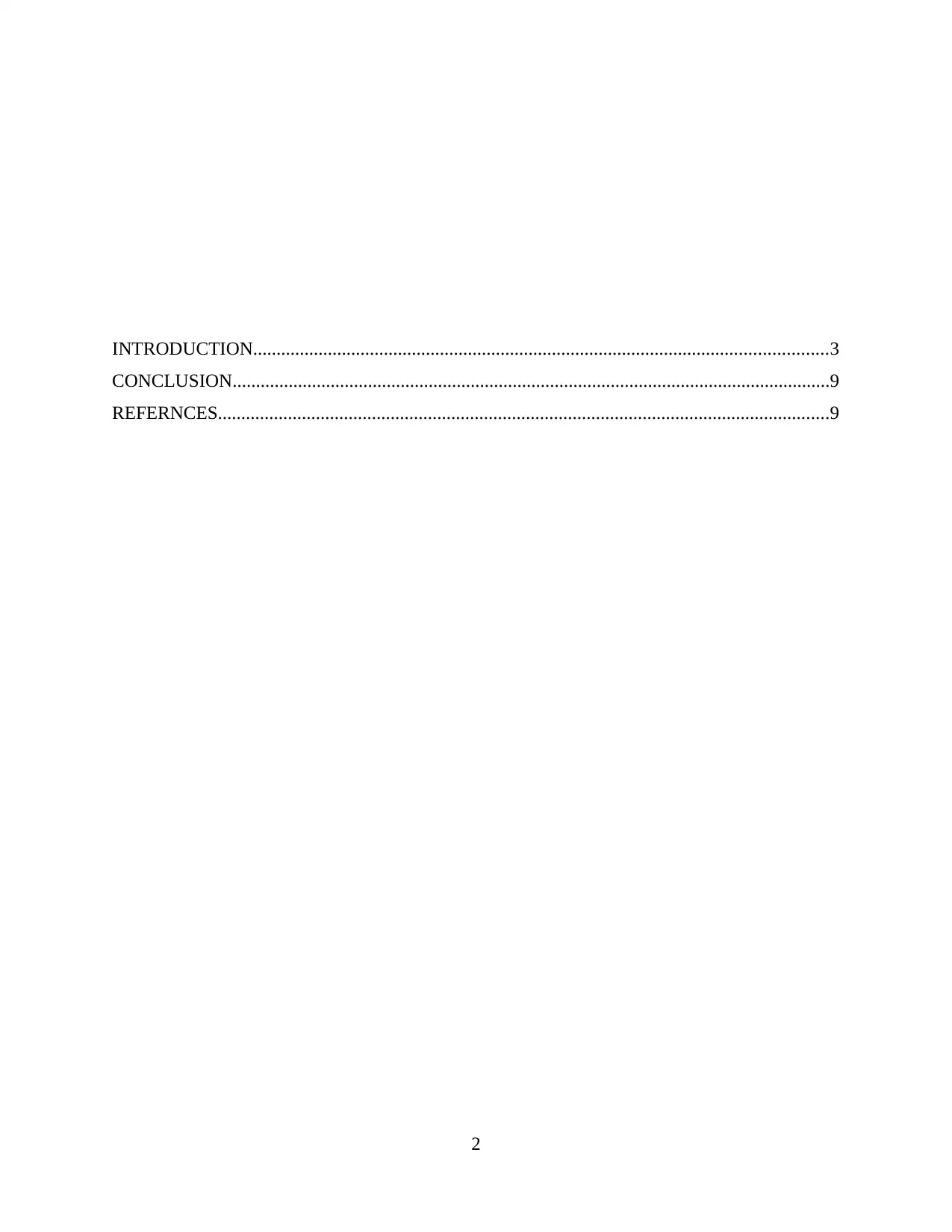
INTRODUCTION...........................................................................................................................3
CONCLUSION................................................................................................................................9
REFERNCES...................................................................................................................................9
2
CONCLUSION................................................................................................................................9
REFERNCES...................................................................................................................................9
2
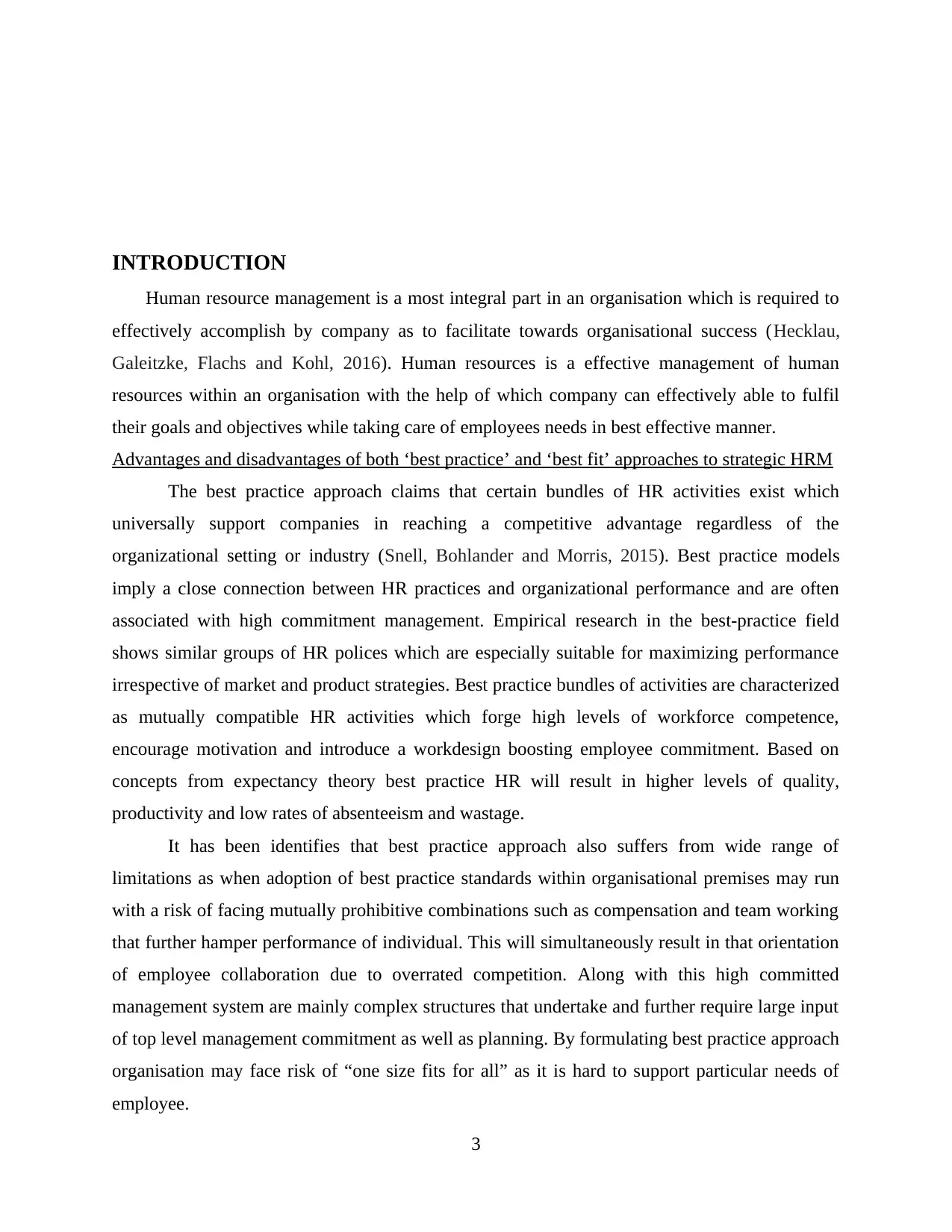
INTRODUCTION
Human resource management is a most integral part in an organisation which is required to
effectively accomplish by company as to facilitate towards organisational success (Hecklau,
Galeitzke, Flachs and Kohl, 2016). Human resources is a effective management of human
resources within an organisation with the help of which company can effectively able to fulfil
their goals and objectives while taking care of employees needs in best effective manner.
Advantages and disadvantages of both ‘best practice’ and ‘best fit’ approaches to strategic HRM
The best practice approach claims that certain bundles of HR activities exist which
universally support companies in reaching a competitive advantage regardless of the
organizational setting or industry (Snell, Bohlander and Morris, 2015). Best practice models
imply a close connection between HR practices and organizational performance and are often
associated with high commitment management. Empirical research in the best-practice field
shows similar groups of HR polices which are especially suitable for maximizing performance
irrespective of market and product strategies. Best practice bundles of activities are characterized
as mutually compatible HR activities which forge high levels of workforce competence,
encourage motivation and introduce a workdesign boosting employee commitment. Based on
concepts from expectancy theory best practice HR will result in higher levels of quality,
productivity and low rates of absenteeism and wastage.
It has been identifies that best practice approach also suffers from wide range of
limitations as when adoption of best practice standards within organisational premises may run
with a risk of facing mutually prohibitive combinations such as compensation and team working
that further hamper performance of individual. This will simultaneously result in that orientation
of employee collaboration due to overrated competition. Along with this high committed
management system are mainly complex structures that undertake and further require large input
of top level management commitment as well as planning. By formulating best practice approach
organisation may face risk of “one size fits for all” as it is hard to support particular needs of
employee.
3
Human resource management is a most integral part in an organisation which is required to
effectively accomplish by company as to facilitate towards organisational success (Hecklau,
Galeitzke, Flachs and Kohl, 2016). Human resources is a effective management of human
resources within an organisation with the help of which company can effectively able to fulfil
their goals and objectives while taking care of employees needs in best effective manner.
Advantages and disadvantages of both ‘best practice’ and ‘best fit’ approaches to strategic HRM
The best practice approach claims that certain bundles of HR activities exist which
universally support companies in reaching a competitive advantage regardless of the
organizational setting or industry (Snell, Bohlander and Morris, 2015). Best practice models
imply a close connection between HR practices and organizational performance and are often
associated with high commitment management. Empirical research in the best-practice field
shows similar groups of HR polices which are especially suitable for maximizing performance
irrespective of market and product strategies. Best practice bundles of activities are characterized
as mutually compatible HR activities which forge high levels of workforce competence,
encourage motivation and introduce a workdesign boosting employee commitment. Based on
concepts from expectancy theory best practice HR will result in higher levels of quality,
productivity and low rates of absenteeism and wastage.
It has been identifies that best practice approach also suffers from wide range of
limitations as when adoption of best practice standards within organisational premises may run
with a risk of facing mutually prohibitive combinations such as compensation and team working
that further hamper performance of individual. This will simultaneously result in that orientation
of employee collaboration due to overrated competition. Along with this high committed
management system are mainly complex structures that undertake and further require large input
of top level management commitment as well as planning. By formulating best practice approach
organisation may face risk of “one size fits for all” as it is hard to support particular needs of
employee.
3
⊘ This is a preview!⊘
Do you want full access?
Subscribe today to unlock all pages.

Trusted by 1+ million students worldwide
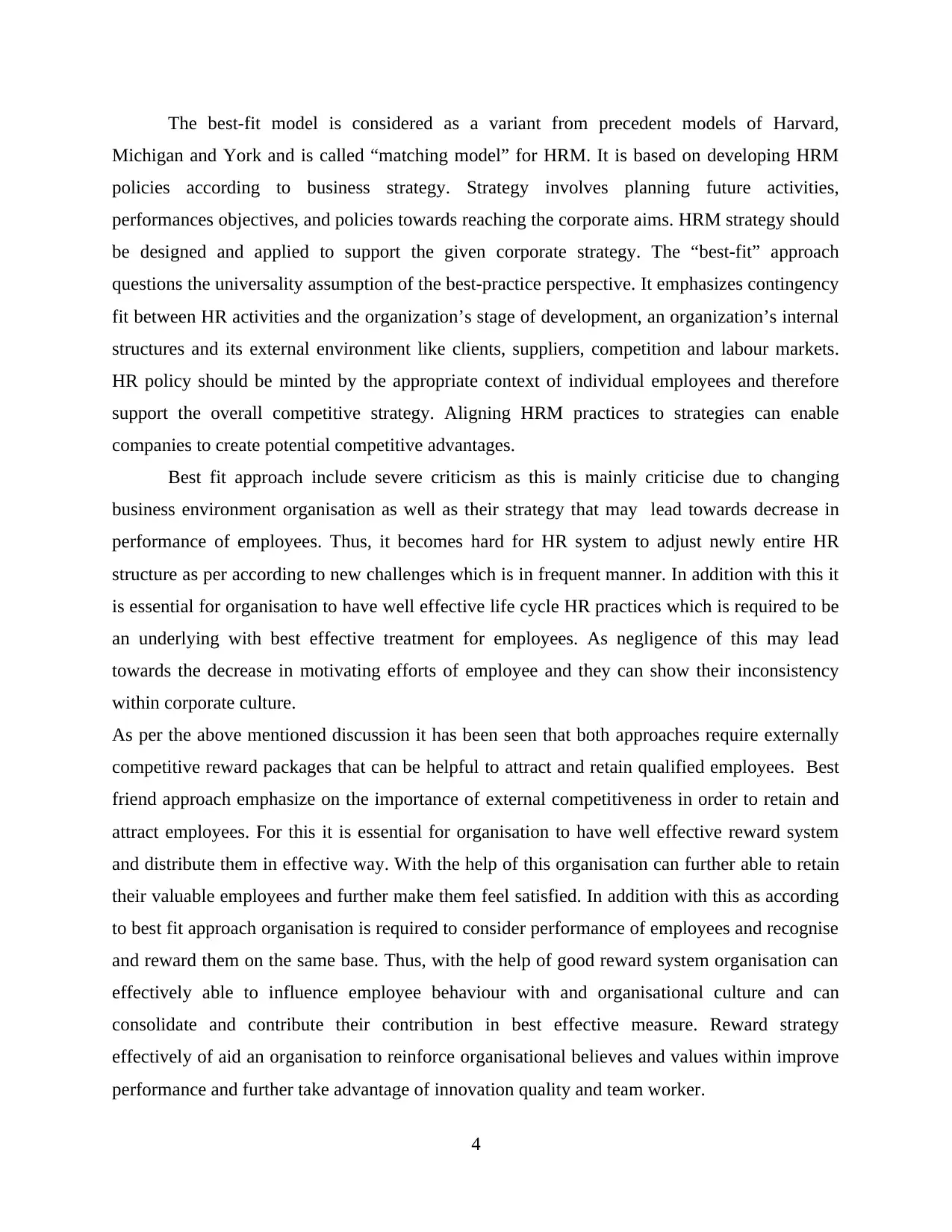
The best-fit model is considered as a variant from precedent models of Harvard,
Michigan and York and is called “matching model” for HRM. It is based on developing HRM
policies according to business strategy. Strategy involves planning future activities,
performances objectives, and policies towards reaching the corporate aims. HRM strategy should
be designed and applied to support the given corporate strategy. The “best-fit” approach
questions the universality assumption of the best-practice perspective. It emphasizes contingency
fit between HR activities and the organization’s stage of development, an organization’s internal
structures and its external environment like clients, suppliers, competition and labour markets.
HR policy should be minted by the appropriate context of individual employees and therefore
support the overall competitive strategy. Aligning HRM practices to strategies can enable
companies to create potential competitive advantages.
Best fit approach include severe criticism as this is mainly criticise due to changing
business environment organisation as well as their strategy that may lead towards decrease in
performance of employees. Thus, it becomes hard for HR system to adjust newly entire HR
structure as per according to new challenges which is in frequent manner. In addition with this it
is essential for organisation to have well effective life cycle HR practices which is required to be
an underlying with best effective treatment for employees. As negligence of this may lead
towards the decrease in motivating efforts of employee and they can show their inconsistency
within corporate culture.
As per the above mentioned discussion it has been seen that both approaches require externally
competitive reward packages that can be helpful to attract and retain qualified employees. Best
friend approach emphasize on the importance of external competitiveness in order to retain and
attract employees. For this it is essential for organisation to have well effective reward system
and distribute them in effective way. With the help of this organisation can further able to retain
their valuable employees and further make them feel satisfied. In addition with this as according
to best fit approach organisation is required to consider performance of employees and recognise
and reward them on the same base. Thus, with the help of good reward system organisation can
effectively able to influence employee behaviour with and organisational culture and can
consolidate and contribute their contribution in best effective measure. Reward strategy
effectively of aid an organisation to reinforce organisational believes and values within improve
performance and further take advantage of innovation quality and team worker.
4
Michigan and York and is called “matching model” for HRM. It is based on developing HRM
policies according to business strategy. Strategy involves planning future activities,
performances objectives, and policies towards reaching the corporate aims. HRM strategy should
be designed and applied to support the given corporate strategy. The “best-fit” approach
questions the universality assumption of the best-practice perspective. It emphasizes contingency
fit between HR activities and the organization’s stage of development, an organization’s internal
structures and its external environment like clients, suppliers, competition and labour markets.
HR policy should be minted by the appropriate context of individual employees and therefore
support the overall competitive strategy. Aligning HRM practices to strategies can enable
companies to create potential competitive advantages.
Best fit approach include severe criticism as this is mainly criticise due to changing
business environment organisation as well as their strategy that may lead towards decrease in
performance of employees. Thus, it becomes hard for HR system to adjust newly entire HR
structure as per according to new challenges which is in frequent manner. In addition with this it
is essential for organisation to have well effective life cycle HR practices which is required to be
an underlying with best effective treatment for employees. As negligence of this may lead
towards the decrease in motivating efforts of employee and they can show their inconsistency
within corporate culture.
As per the above mentioned discussion it has been seen that both approaches require externally
competitive reward packages that can be helpful to attract and retain qualified employees. Best
friend approach emphasize on the importance of external competitiveness in order to retain and
attract employees. For this it is essential for organisation to have well effective reward system
and distribute them in effective way. With the help of this organisation can further able to retain
their valuable employees and further make them feel satisfied. In addition with this as according
to best fit approach organisation is required to consider performance of employees and recognise
and reward them on the same base. Thus, with the help of good reward system organisation can
effectively able to influence employee behaviour with and organisational culture and can
consolidate and contribute their contribution in best effective measure. Reward strategy
effectively of aid an organisation to reinforce organisational believes and values within improve
performance and further take advantage of innovation quality and team worker.
4
Paraphrase This Document
Need a fresh take? Get an instant paraphrase of this document with our AI Paraphraser
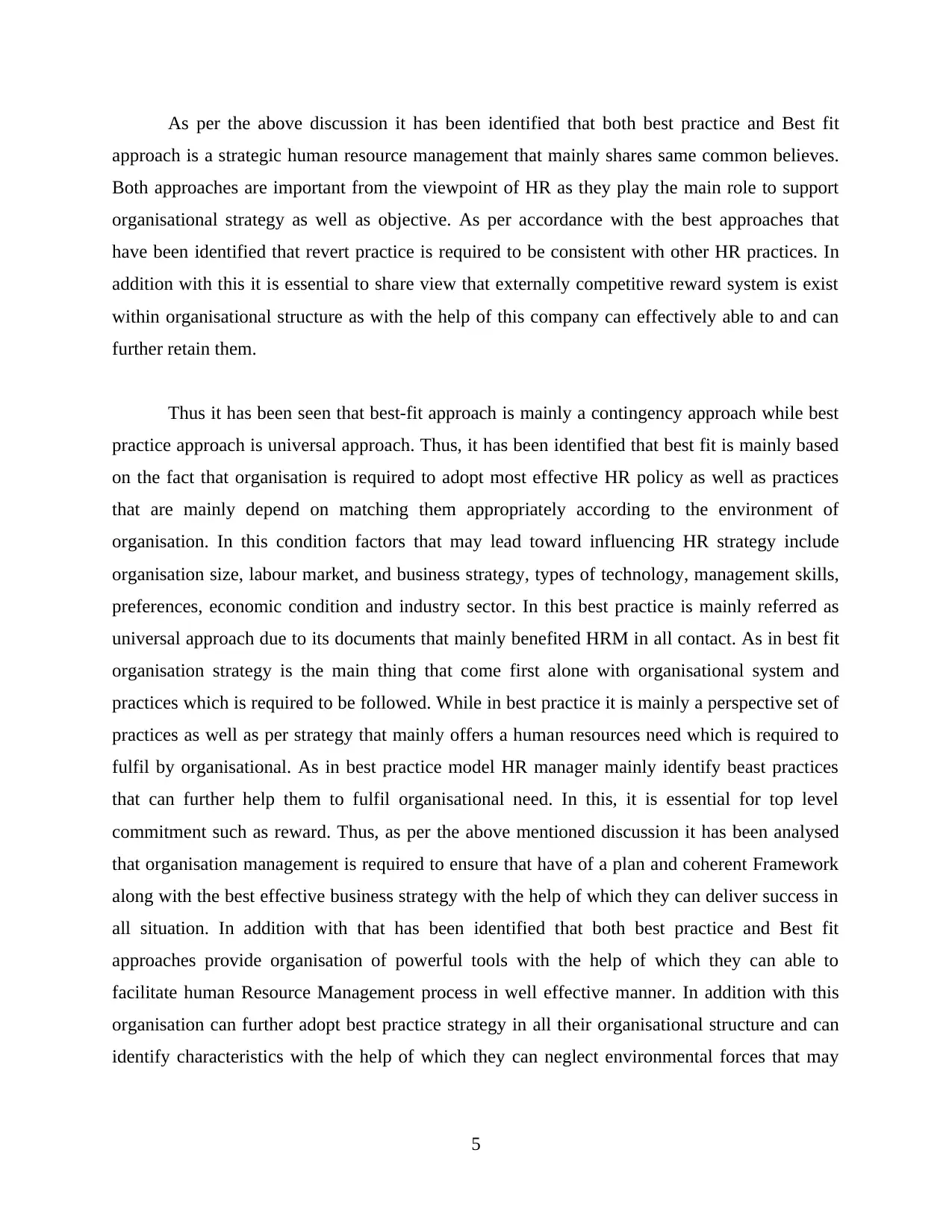
As per the above discussion it has been identified that both best practice and Best fit
approach is a strategic human resource management that mainly shares same common believes.
Both approaches are important from the viewpoint of HR as they play the main role to support
organisational strategy as well as objective. As per accordance with the best approaches that
have been identified that revert practice is required to be consistent with other HR practices. In
addition with this it is essential to share view that externally competitive reward system is exist
within organisational structure as with the help of this company can effectively able to and can
further retain them.
Thus it has been seen that best-fit approach is mainly a contingency approach while best
practice approach is universal approach. Thus, it has been identified that best fit is mainly based
on the fact that organisation is required to adopt most effective HR policy as well as practices
that are mainly depend on matching them appropriately according to the environment of
organisation. In this condition factors that may lead toward influencing HR strategy include
organisation size, labour market, and business strategy, types of technology, management skills,
preferences, economic condition and industry sector. In this best practice is mainly referred as
universal approach due to its documents that mainly benefited HRM in all contact. As in best fit
organisation strategy is the main thing that come first alone with organisational system and
practices which is required to be followed. While in best practice it is mainly a perspective set of
practices as well as per strategy that mainly offers a human resources need which is required to
fulfil by organisational. As in best practice model HR manager mainly identify beast practices
that can further help them to fulfil organisational need. In this, it is essential for top level
commitment such as reward. Thus, as per the above mentioned discussion it has been analysed
that organisation management is required to ensure that have of a plan and coherent Framework
along with the best effective business strategy with the help of which they can deliver success in
all situation. In addition with that has been identified that both best practice and Best fit
approaches provide organisation of powerful tools with the help of which they can able to
facilitate human Resource Management process in well effective manner. In addition with this
organisation can further adopt best practice strategy in all their organisational structure and can
identify characteristics with the help of which they can neglect environmental forces that may
5
approach is a strategic human resource management that mainly shares same common believes.
Both approaches are important from the viewpoint of HR as they play the main role to support
organisational strategy as well as objective. As per accordance with the best approaches that
have been identified that revert practice is required to be consistent with other HR practices. In
addition with this it is essential to share view that externally competitive reward system is exist
within organisational structure as with the help of this company can effectively able to and can
further retain them.
Thus it has been seen that best-fit approach is mainly a contingency approach while best
practice approach is universal approach. Thus, it has been identified that best fit is mainly based
on the fact that organisation is required to adopt most effective HR policy as well as practices
that are mainly depend on matching them appropriately according to the environment of
organisation. In this condition factors that may lead toward influencing HR strategy include
organisation size, labour market, and business strategy, types of technology, management skills,
preferences, economic condition and industry sector. In this best practice is mainly referred as
universal approach due to its documents that mainly benefited HRM in all contact. As in best fit
organisation strategy is the main thing that come first alone with organisational system and
practices which is required to be followed. While in best practice it is mainly a perspective set of
practices as well as per strategy that mainly offers a human resources need which is required to
fulfil by organisational. As in best practice model HR manager mainly identify beast practices
that can further help them to fulfil organisational need. In this, it is essential for top level
commitment such as reward. Thus, as per the above mentioned discussion it has been analysed
that organisation management is required to ensure that have of a plan and coherent Framework
along with the best effective business strategy with the help of which they can deliver success in
all situation. In addition with that has been identified that both best practice and Best fit
approaches provide organisation of powerful tools with the help of which they can able to
facilitate human Resource Management process in well effective manner. In addition with this
organisation can further adopt best practice strategy in all their organisational structure and can
identify characteristics with the help of which they can neglect environmental forces that may
5
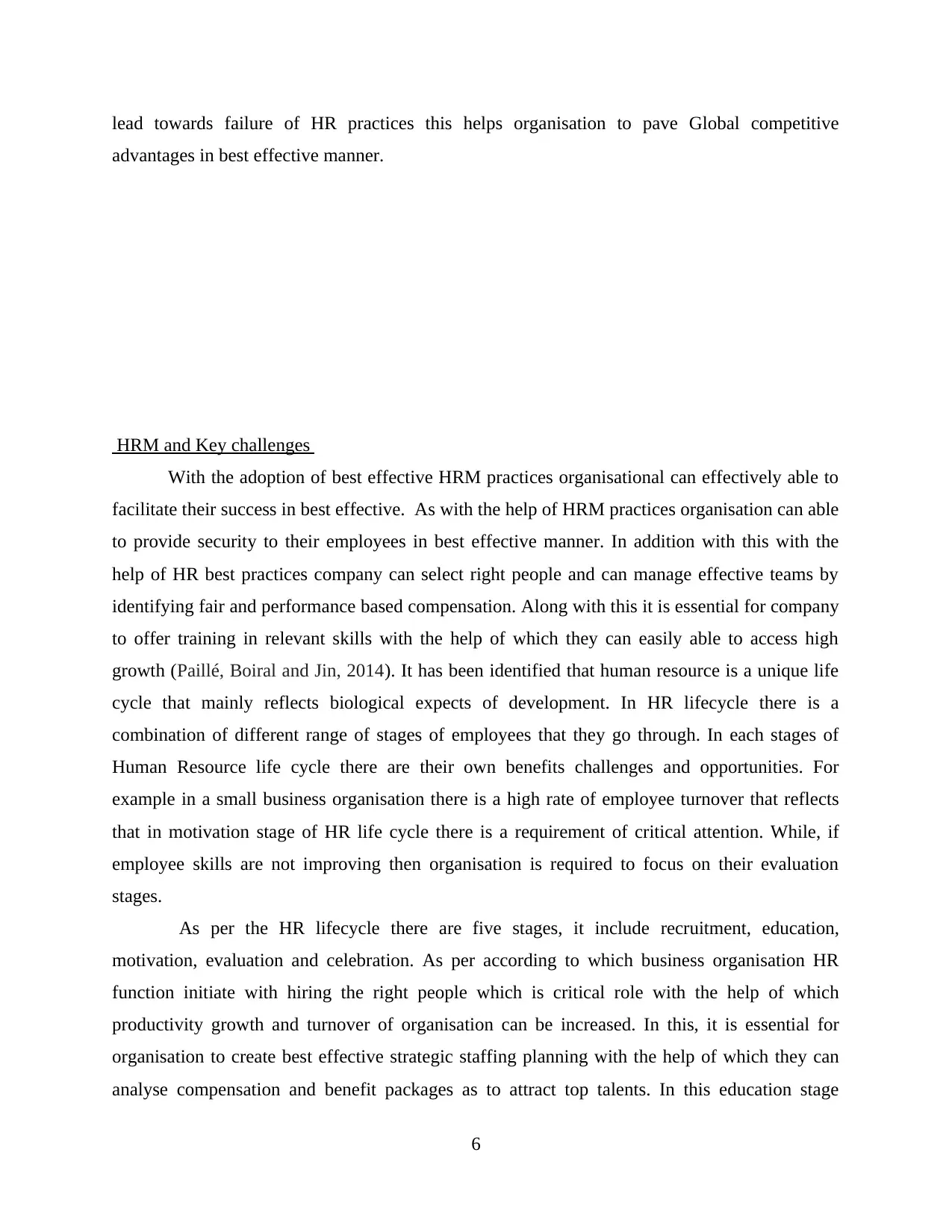
lead towards failure of HR practices this helps organisation to pave Global competitive
advantages in best effective manner.
HRM and Key challenges
With the adoption of best effective HRM practices organisational can effectively able to
facilitate their success in best effective. As with the help of HRM practices organisation can able
to provide security to their employees in best effective manner. In addition with this with the
help of HR best practices company can select right people and can manage effective teams by
identifying fair and performance based compensation. Along with this it is essential for company
to offer training in relevant skills with the help of which they can easily able to access high
growth (Paillé, Boiral and Jin, 2014). It has been identified that human resource is a unique life
cycle that mainly reflects biological expects of development. In HR lifecycle there is a
combination of different range of stages of employees that they go through. In each stages of
Human Resource life cycle there are their own benefits challenges and opportunities. For
example in a small business organisation there is a high rate of employee turnover that reflects
that in motivation stage of HR life cycle there is a requirement of critical attention. While, if
employee skills are not improving then organisation is required to focus on their evaluation
stages.
As per the HR lifecycle there are five stages, it include recruitment, education,
motivation, evaluation and celebration. As per according to which business organisation HR
function initiate with hiring the right people which is critical role with the help of which
productivity growth and turnover of organisation can be increased. In this, it is essential for
organisation to create best effective strategic staffing planning with the help of which they can
analyse compensation and benefit packages as to attract top talents. In this education stage
6
advantages in best effective manner.
HRM and Key challenges
With the adoption of best effective HRM practices organisational can effectively able to
facilitate their success in best effective. As with the help of HRM practices organisation can able
to provide security to their employees in best effective manner. In addition with this with the
help of HR best practices company can select right people and can manage effective teams by
identifying fair and performance based compensation. Along with this it is essential for company
to offer training in relevant skills with the help of which they can easily able to access high
growth (Paillé, Boiral and Jin, 2014). It has been identified that human resource is a unique life
cycle that mainly reflects biological expects of development. In HR lifecycle there is a
combination of different range of stages of employees that they go through. In each stages of
Human Resource life cycle there are their own benefits challenges and opportunities. For
example in a small business organisation there is a high rate of employee turnover that reflects
that in motivation stage of HR life cycle there is a requirement of critical attention. While, if
employee skills are not improving then organisation is required to focus on their evaluation
stages.
As per the HR lifecycle there are five stages, it include recruitment, education,
motivation, evaluation and celebration. As per according to which business organisation HR
function initiate with hiring the right people which is critical role with the help of which
productivity growth and turnover of organisation can be increased. In this, it is essential for
organisation to create best effective strategic staffing planning with the help of which they can
analyse compensation and benefit packages as to attract top talents. In this education stage
6
⊘ This is a preview!⊘
Do you want full access?
Subscribe today to unlock all pages.

Trusted by 1+ million students worldwide
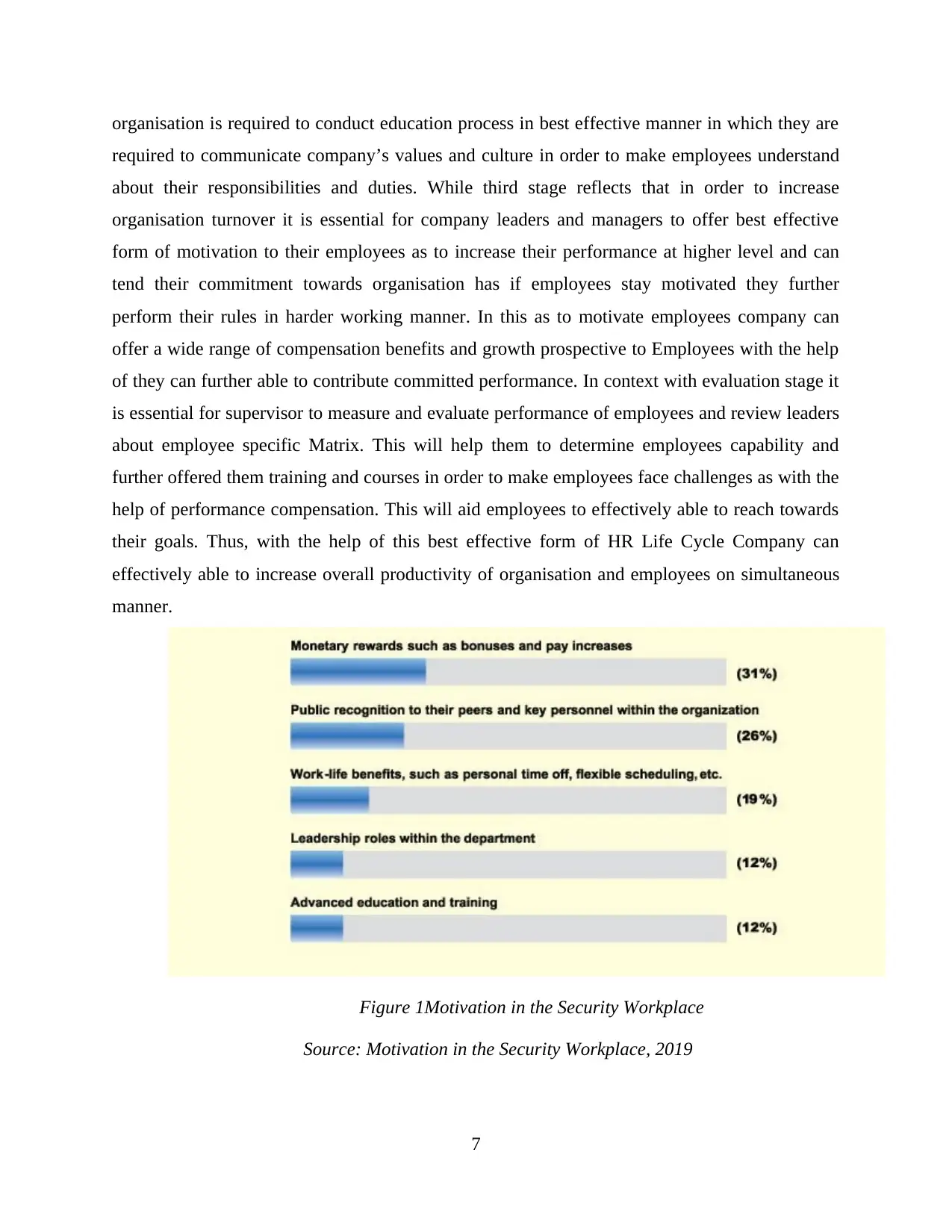
organisation is required to conduct education process in best effective manner in which they are
required to communicate company’s values and culture in order to make employees understand
about their responsibilities and duties. While third stage reflects that in order to increase
organisation turnover it is essential for company leaders and managers to offer best effective
form of motivation to their employees as to increase their performance at higher level and can
tend their commitment towards organisation has if employees stay motivated they further
perform their rules in harder working manner. In this as to motivate employees company can
offer a wide range of compensation benefits and growth prospective to Employees with the help
of they can further able to contribute committed performance. In context with evaluation stage it
is essential for supervisor to measure and evaluate performance of employees and review leaders
about employee specific Matrix. This will help them to determine employees capability and
further offered them training and courses in order to make employees face challenges as with the
help of performance compensation. This will aid employees to effectively able to reach towards
their goals. Thus, with the help of this best effective form of HR Life Cycle Company can
effectively able to increase overall productivity of organisation and employees on simultaneous
manner.
Figure 1Motivation in the Security Workplace
Source: Motivation in the Security Workplace, 2019
7
required to communicate company’s values and culture in order to make employees understand
about their responsibilities and duties. While third stage reflects that in order to increase
organisation turnover it is essential for company leaders and managers to offer best effective
form of motivation to their employees as to increase their performance at higher level and can
tend their commitment towards organisation has if employees stay motivated they further
perform their rules in harder working manner. In this as to motivate employees company can
offer a wide range of compensation benefits and growth prospective to Employees with the help
of they can further able to contribute committed performance. In context with evaluation stage it
is essential for supervisor to measure and evaluate performance of employees and review leaders
about employee specific Matrix. This will help them to determine employees capability and
further offered them training and courses in order to make employees face challenges as with the
help of performance compensation. This will aid employees to effectively able to reach towards
their goals. Thus, with the help of this best effective form of HR Life Cycle Company can
effectively able to increase overall productivity of organisation and employees on simultaneous
manner.
Figure 1Motivation in the Security Workplace
Source: Motivation in the Security Workplace, 2019
7
Paraphrase This Document
Need a fresh take? Get an instant paraphrase of this document with our AI Paraphraser
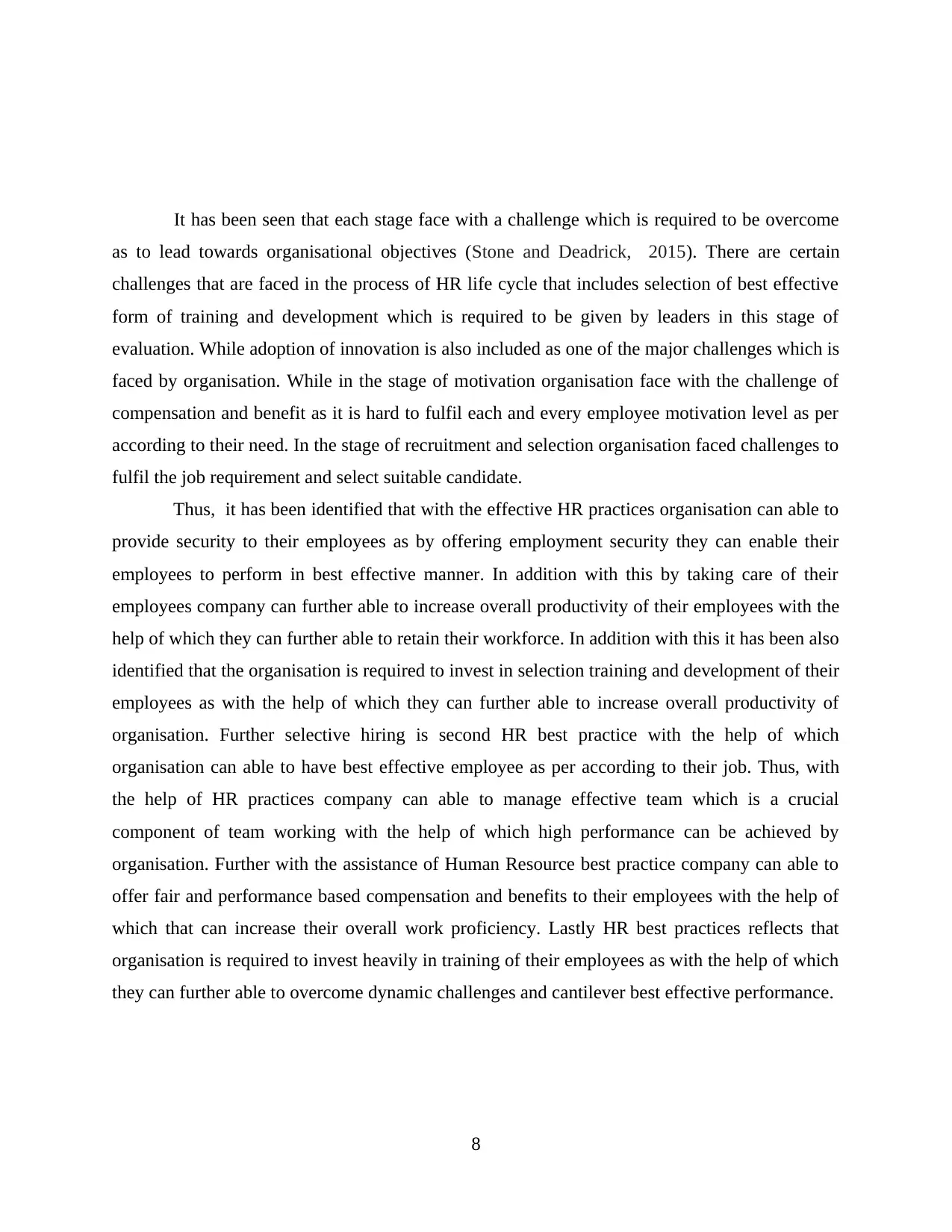
It has been seen that each stage face with a challenge which is required to be overcome
as to lead towards organisational objectives (Stone and Deadrick, 2015). There are certain
challenges that are faced in the process of HR life cycle that includes selection of best effective
form of training and development which is required to be given by leaders in this stage of
evaluation. While adoption of innovation is also included as one of the major challenges which is
faced by organisation. While in the stage of motivation organisation face with the challenge of
compensation and benefit as it is hard to fulfil each and every employee motivation level as per
according to their need. In the stage of recruitment and selection organisation faced challenges to
fulfil the job requirement and select suitable candidate.
Thus, it has been identified that with the effective HR practices organisation can able to
provide security to their employees as by offering employment security they can enable their
employees to perform in best effective manner. In addition with this by taking care of their
employees company can further able to increase overall productivity of their employees with the
help of which they can further able to retain their workforce. In addition with this it has been also
identified that the organisation is required to invest in selection training and development of their
employees as with the help of which they can further able to increase overall productivity of
organisation. Further selective hiring is second HR best practice with the help of which
organisation can able to have best effective employee as per according to their job. Thus, with
the help of HR practices company can able to manage effective team which is a crucial
component of team working with the help of which high performance can be achieved by
organisation. Further with the assistance of Human Resource best practice company can able to
offer fair and performance based compensation and benefits to their employees with the help of
which that can increase their overall work proficiency. Lastly HR best practices reflects that
organisation is required to invest heavily in training of their employees as with the help of which
they can further able to overcome dynamic challenges and cantilever best effective performance.
8
as to lead towards organisational objectives (Stone and Deadrick, 2015). There are certain
challenges that are faced in the process of HR life cycle that includes selection of best effective
form of training and development which is required to be given by leaders in this stage of
evaluation. While adoption of innovation is also included as one of the major challenges which is
faced by organisation. While in the stage of motivation organisation face with the challenge of
compensation and benefit as it is hard to fulfil each and every employee motivation level as per
according to their need. In the stage of recruitment and selection organisation faced challenges to
fulfil the job requirement and select suitable candidate.
Thus, it has been identified that with the effective HR practices organisation can able to
provide security to their employees as by offering employment security they can enable their
employees to perform in best effective manner. In addition with this by taking care of their
employees company can further able to increase overall productivity of their employees with the
help of which they can further able to retain their workforce. In addition with this it has been also
identified that the organisation is required to invest in selection training and development of their
employees as with the help of which they can further able to increase overall productivity of
organisation. Further selective hiring is second HR best practice with the help of which
organisation can able to have best effective employee as per according to their job. Thus, with
the help of HR practices company can able to manage effective team which is a crucial
component of team working with the help of which high performance can be achieved by
organisation. Further with the assistance of Human Resource best practice company can able to
offer fair and performance based compensation and benefits to their employees with the help of
which that can increase their overall work proficiency. Lastly HR best practices reflects that
organisation is required to invest heavily in training of their employees as with the help of which
they can further able to overcome dynamic challenges and cantilever best effective performance.
8
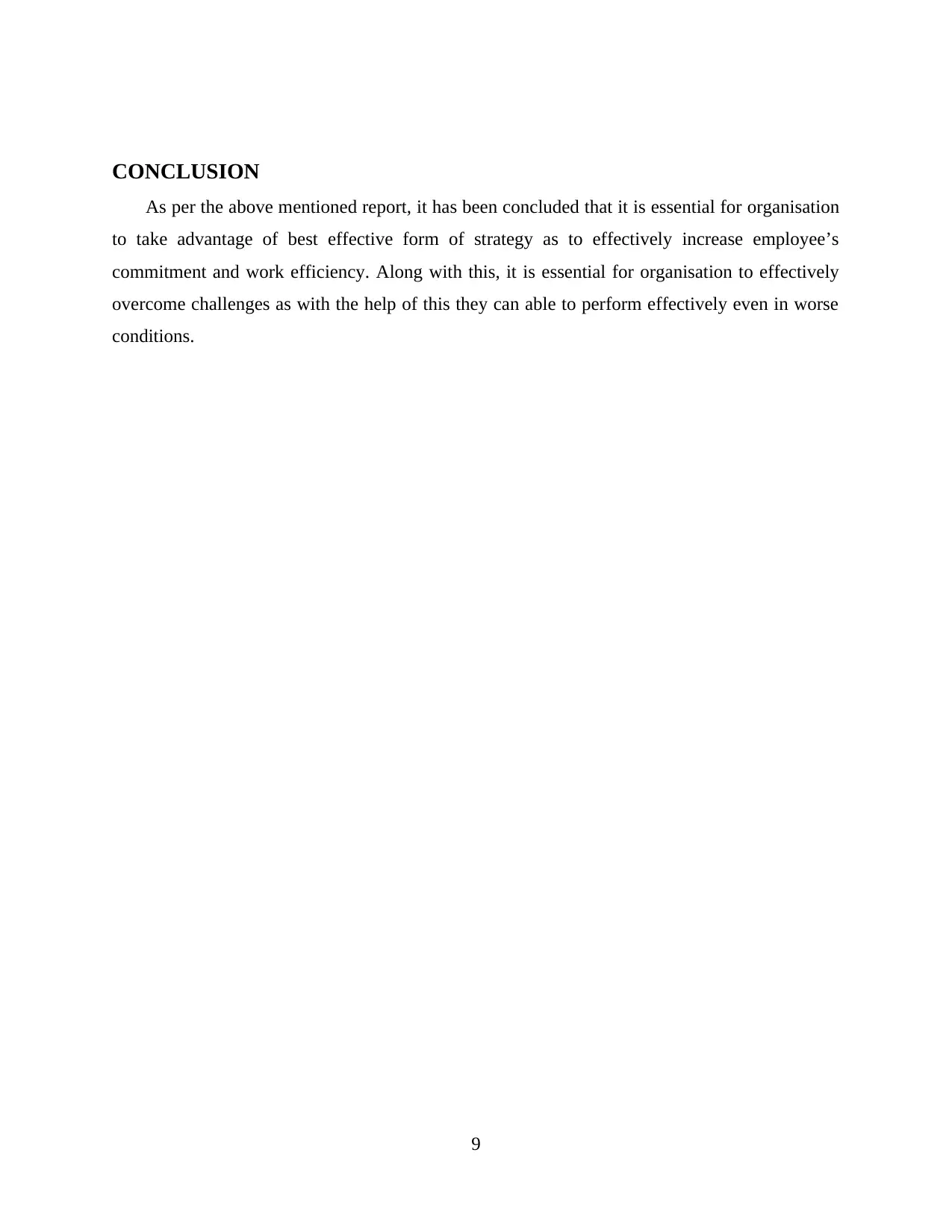
CONCLUSION
As per the above mentioned report, it has been concluded that it is essential for organisation
to take advantage of best effective form of strategy as to effectively increase employee’s
commitment and work efficiency. Along with this, it is essential for organisation to effectively
overcome challenges as with the help of this they can able to perform effectively even in worse
conditions.
9
As per the above mentioned report, it has been concluded that it is essential for organisation
to take advantage of best effective form of strategy as to effectively increase employee’s
commitment and work efficiency. Along with this, it is essential for organisation to effectively
overcome challenges as with the help of this they can able to perform effectively even in worse
conditions.
9
⊘ This is a preview!⊘
Do you want full access?
Subscribe today to unlock all pages.

Trusted by 1+ million students worldwide
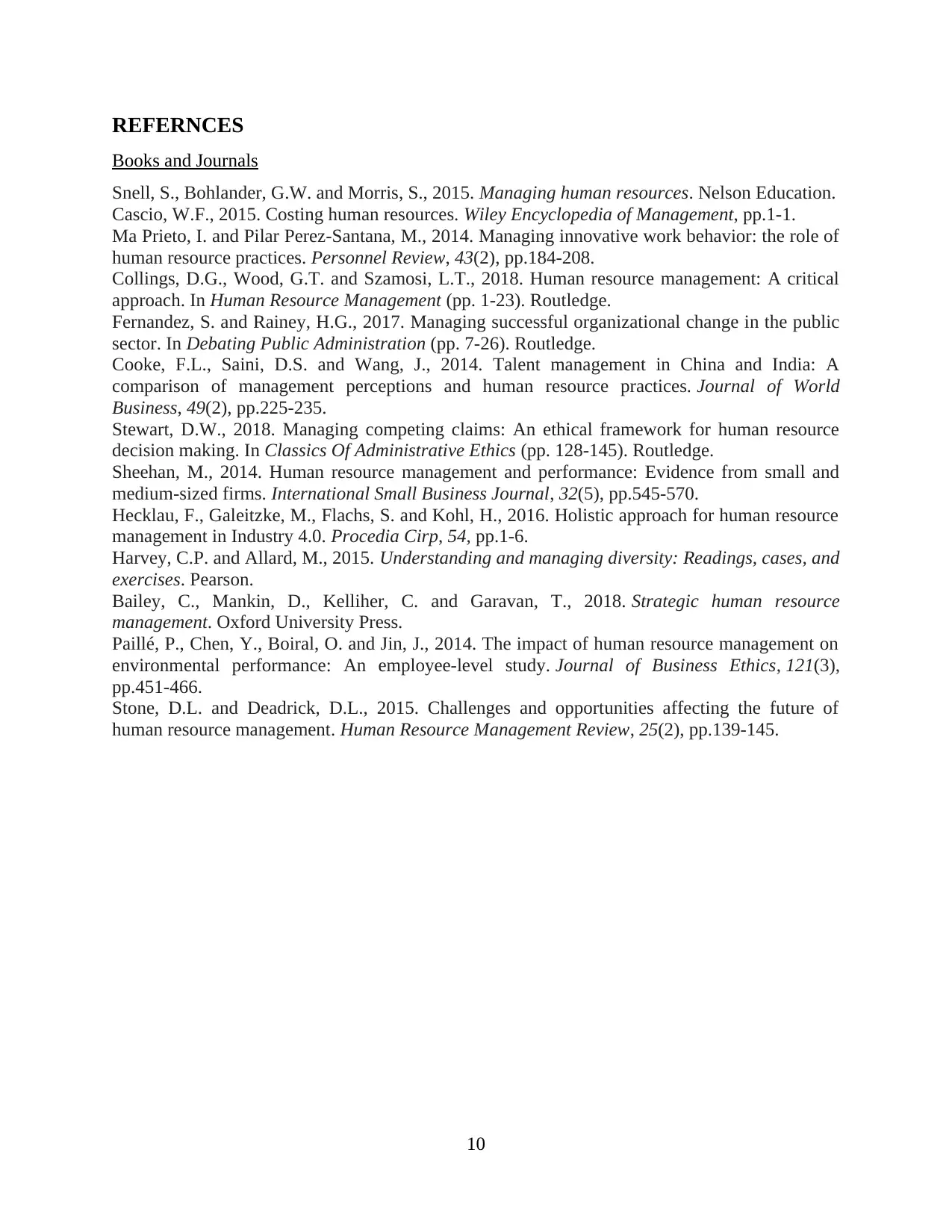
REFERNCES
Books and Journals
Snell, S., Bohlander, G.W. and Morris, S., 2015. Managing human resources. Nelson Education.
Cascio, W.F., 2015. Costing human resources. Wiley Encyclopedia of Management, pp.1-1.
Ma Prieto, I. and Pilar Perez-Santana, M., 2014. Managing innovative work behavior: the role of
human resource practices. Personnel Review, 43(2), pp.184-208.
Collings, D.G., Wood, G.T. and Szamosi, L.T., 2018. Human resource management: A critical
approach. In Human Resource Management (pp. 1-23). Routledge.
Fernandez, S. and Rainey, H.G., 2017. Managing successful organizational change in the public
sector. In Debating Public Administration (pp. 7-26). Routledge.
Cooke, F.L., Saini, D.S. and Wang, J., 2014. Talent management in China and India: A
comparison of management perceptions and human resource practices. Journal of World
Business, 49(2), pp.225-235.
Stewart, D.W., 2018. Managing competing claims: An ethical framework for human resource
decision making. In Classics Of Administrative Ethics (pp. 128-145). Routledge.
Sheehan, M., 2014. Human resource management and performance: Evidence from small and
medium-sized firms. International Small Business Journal, 32(5), pp.545-570.
Hecklau, F., Galeitzke, M., Flachs, S. and Kohl, H., 2016. Holistic approach for human resource
management in Industry 4.0. Procedia Cirp, 54, pp.1-6.
Harvey, C.P. and Allard, M., 2015. Understanding and managing diversity: Readings, cases, and
exercises. Pearson.
Bailey, C., Mankin, D., Kelliher, C. and Garavan, T., 2018. Strategic human resource
management. Oxford University Press.
Paillé, P., Chen, Y., Boiral, O. and Jin, J., 2014. The impact of human resource management on
environmental performance: An employee-level study. Journal of Business Ethics, 121(3),
pp.451-466.
Stone, D.L. and Deadrick, D.L., 2015. Challenges and opportunities affecting the future of
human resource management. Human Resource Management Review, 25(2), pp.139-145.
10
Books and Journals
Snell, S., Bohlander, G.W. and Morris, S., 2015. Managing human resources. Nelson Education.
Cascio, W.F., 2015. Costing human resources. Wiley Encyclopedia of Management, pp.1-1.
Ma Prieto, I. and Pilar Perez-Santana, M., 2014. Managing innovative work behavior: the role of
human resource practices. Personnel Review, 43(2), pp.184-208.
Collings, D.G., Wood, G.T. and Szamosi, L.T., 2018. Human resource management: A critical
approach. In Human Resource Management (pp. 1-23). Routledge.
Fernandez, S. and Rainey, H.G., 2017. Managing successful organizational change in the public
sector. In Debating Public Administration (pp. 7-26). Routledge.
Cooke, F.L., Saini, D.S. and Wang, J., 2014. Talent management in China and India: A
comparison of management perceptions and human resource practices. Journal of World
Business, 49(2), pp.225-235.
Stewart, D.W., 2018. Managing competing claims: An ethical framework for human resource
decision making. In Classics Of Administrative Ethics (pp. 128-145). Routledge.
Sheehan, M., 2014. Human resource management and performance: Evidence from small and
medium-sized firms. International Small Business Journal, 32(5), pp.545-570.
Hecklau, F., Galeitzke, M., Flachs, S. and Kohl, H., 2016. Holistic approach for human resource
management in Industry 4.0. Procedia Cirp, 54, pp.1-6.
Harvey, C.P. and Allard, M., 2015. Understanding and managing diversity: Readings, cases, and
exercises. Pearson.
Bailey, C., Mankin, D., Kelliher, C. and Garavan, T., 2018. Strategic human resource
management. Oxford University Press.
Paillé, P., Chen, Y., Boiral, O. and Jin, J., 2014. The impact of human resource management on
environmental performance: An employee-level study. Journal of Business Ethics, 121(3),
pp.451-466.
Stone, D.L. and Deadrick, D.L., 2015. Challenges and opportunities affecting the future of
human resource management. Human Resource Management Review, 25(2), pp.139-145.
10
Paraphrase This Document
Need a fresh take? Get an instant paraphrase of this document with our AI Paraphraser

11
1 out of 11
Related Documents
Your All-in-One AI-Powered Toolkit for Academic Success.
+13062052269
info@desklib.com
Available 24*7 on WhatsApp / Email
![[object Object]](/_next/static/media/star-bottom.7253800d.svg)
Unlock your academic potential
Copyright © 2020–2025 A2Z Services. All Rights Reserved. Developed and managed by ZUCOL.





